Report: Management Style Interpretation and CVF Analysis
VerifiedAdded on 2023/04/11
|6
|711
|76
Report
AI Summary
This report presents an interpretation of a student's management style using the Competing Values Framework (CVF). The student, a tourism and hospitality manager, self-assesses their skills and identifies strengths in information management, planning, and goal setting, aligning with the internal process and rational goal models. Weaknesses are noted in cohesion and flexibility. The report details the application of these management styles in a professional context, particularly in interacting with diverse customers and managing teams. The student reflects on the CVF survey results, highlighting areas where they excel and areas that need improvement to enhance overall management effectiveness, providing insights into their current approach and areas for professional development.
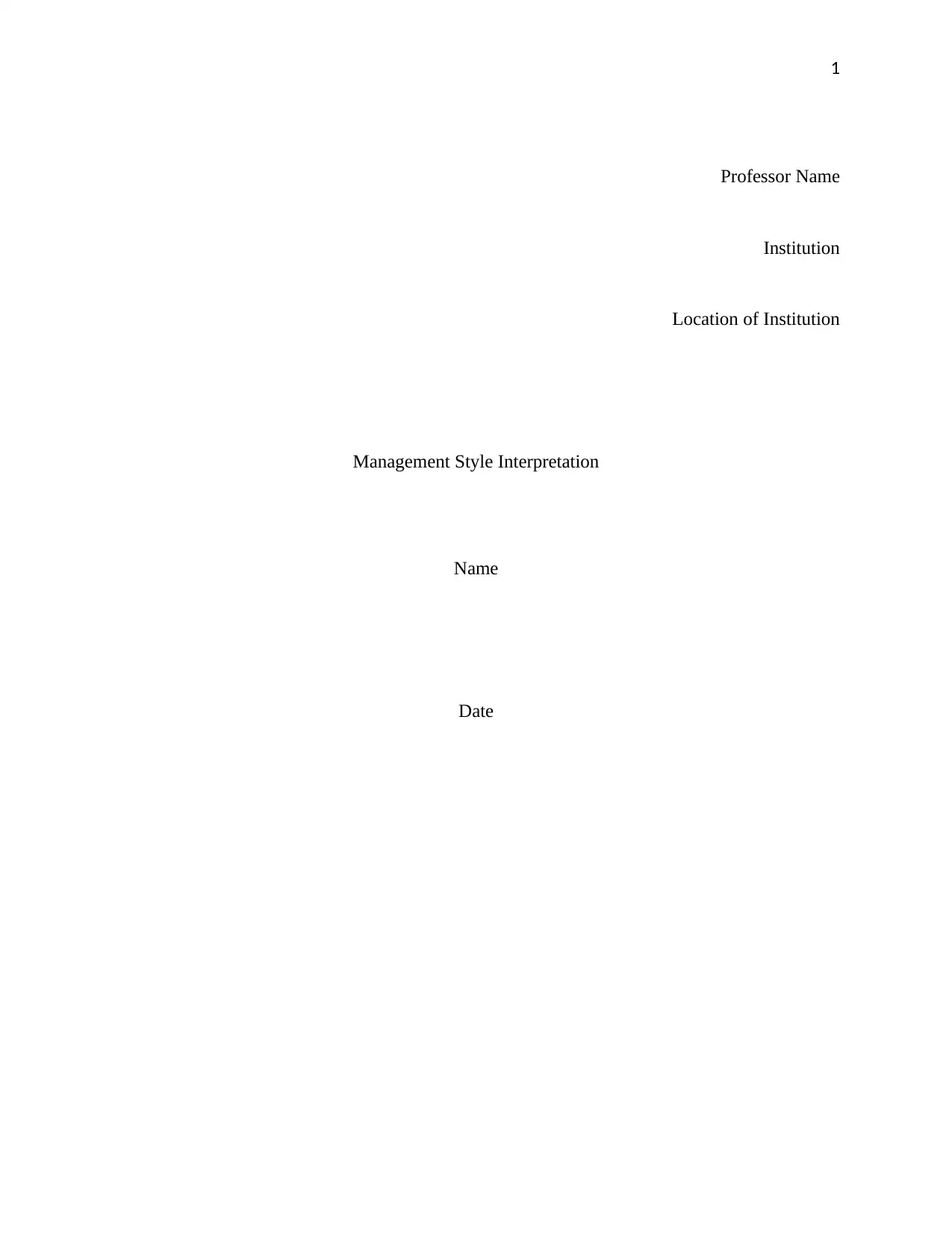
1
Professor Name
Institution
Location of Institution
Management Style Interpretation
Name
Date
Professor Name
Institution
Location of Institution
Management Style Interpretation
Name
Date
Paraphrase This Document
Need a fresh take? Get an instant paraphrase of this document with our AI Paraphraser
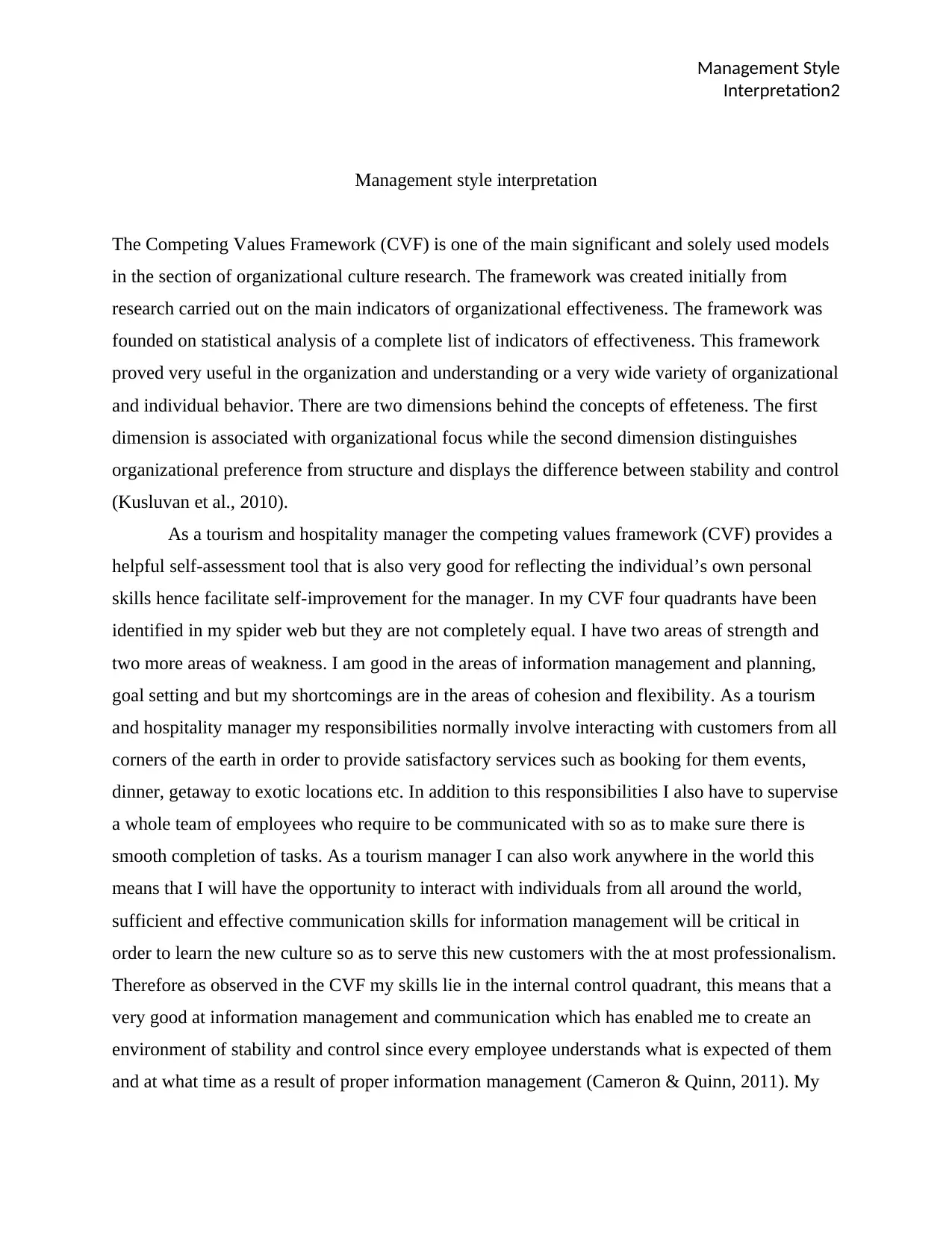
Management Style
Interpretation2
Management style interpretation
The Competing Values Framework (CVF) is one of the main significant and solely used models
in the section of organizational culture research. The framework was created initially from
research carried out on the main indicators of organizational effectiveness. The framework was
founded on statistical analysis of a complete list of indicators of effectiveness. This framework
proved very useful in the organization and understanding or a very wide variety of organizational
and individual behavior. There are two dimensions behind the concepts of effeteness. The first
dimension is associated with organizational focus while the second dimension distinguishes
organizational preference from structure and displays the difference between stability and control
(Kusluvan et al., 2010).
As a tourism and hospitality manager the competing values framework (CVF) provides a
helpful self-assessment tool that is also very good for reflecting the individual’s own personal
skills hence facilitate self-improvement for the manager. In my CVF four quadrants have been
identified in my spider web but they are not completely equal. I have two areas of strength and
two more areas of weakness. I am good in the areas of information management and planning,
goal setting and but my shortcomings are in the areas of cohesion and flexibility. As a tourism
and hospitality manager my responsibilities normally involve interacting with customers from all
corners of the earth in order to provide satisfactory services such as booking for them events,
dinner, getaway to exotic locations etc. In addition to this responsibilities I also have to supervise
a whole team of employees who require to be communicated with so as to make sure there is
smooth completion of tasks. As a tourism manager I can also work anywhere in the world this
means that I will have the opportunity to interact with individuals from all around the world,
sufficient and effective communication skills for information management will be critical in
order to learn the new culture so as to serve this new customers with the at most professionalism.
Therefore as observed in the CVF my skills lie in the internal control quadrant, this means that a
very good at information management and communication which has enabled me to create an
environment of stability and control since every employee understands what is expected of them
and at what time as a result of proper information management (Cameron & Quinn, 2011). My
Interpretation2
Management style interpretation
The Competing Values Framework (CVF) is one of the main significant and solely used models
in the section of organizational culture research. The framework was created initially from
research carried out on the main indicators of organizational effectiveness. The framework was
founded on statistical analysis of a complete list of indicators of effectiveness. This framework
proved very useful in the organization and understanding or a very wide variety of organizational
and individual behavior. There are two dimensions behind the concepts of effeteness. The first
dimension is associated with organizational focus while the second dimension distinguishes
organizational preference from structure and displays the difference between stability and control
(Kusluvan et al., 2010).
As a tourism and hospitality manager the competing values framework (CVF) provides a
helpful self-assessment tool that is also very good for reflecting the individual’s own personal
skills hence facilitate self-improvement for the manager. In my CVF four quadrants have been
identified in my spider web but they are not completely equal. I have two areas of strength and
two more areas of weakness. I am good in the areas of information management and planning,
goal setting and but my shortcomings are in the areas of cohesion and flexibility. As a tourism
and hospitality manager my responsibilities normally involve interacting with customers from all
corners of the earth in order to provide satisfactory services such as booking for them events,
dinner, getaway to exotic locations etc. In addition to this responsibilities I also have to supervise
a whole team of employees who require to be communicated with so as to make sure there is
smooth completion of tasks. As a tourism manager I can also work anywhere in the world this
means that I will have the opportunity to interact with individuals from all around the world,
sufficient and effective communication skills for information management will be critical in
order to learn the new culture so as to serve this new customers with the at most professionalism.
Therefore as observed in the CVF my skills lie in the internal control quadrant, this means that a
very good at information management and communication which has enabled me to create an
environment of stability and control since every employee understands what is expected of them
and at what time as a result of proper information management (Cameron & Quinn, 2011). My
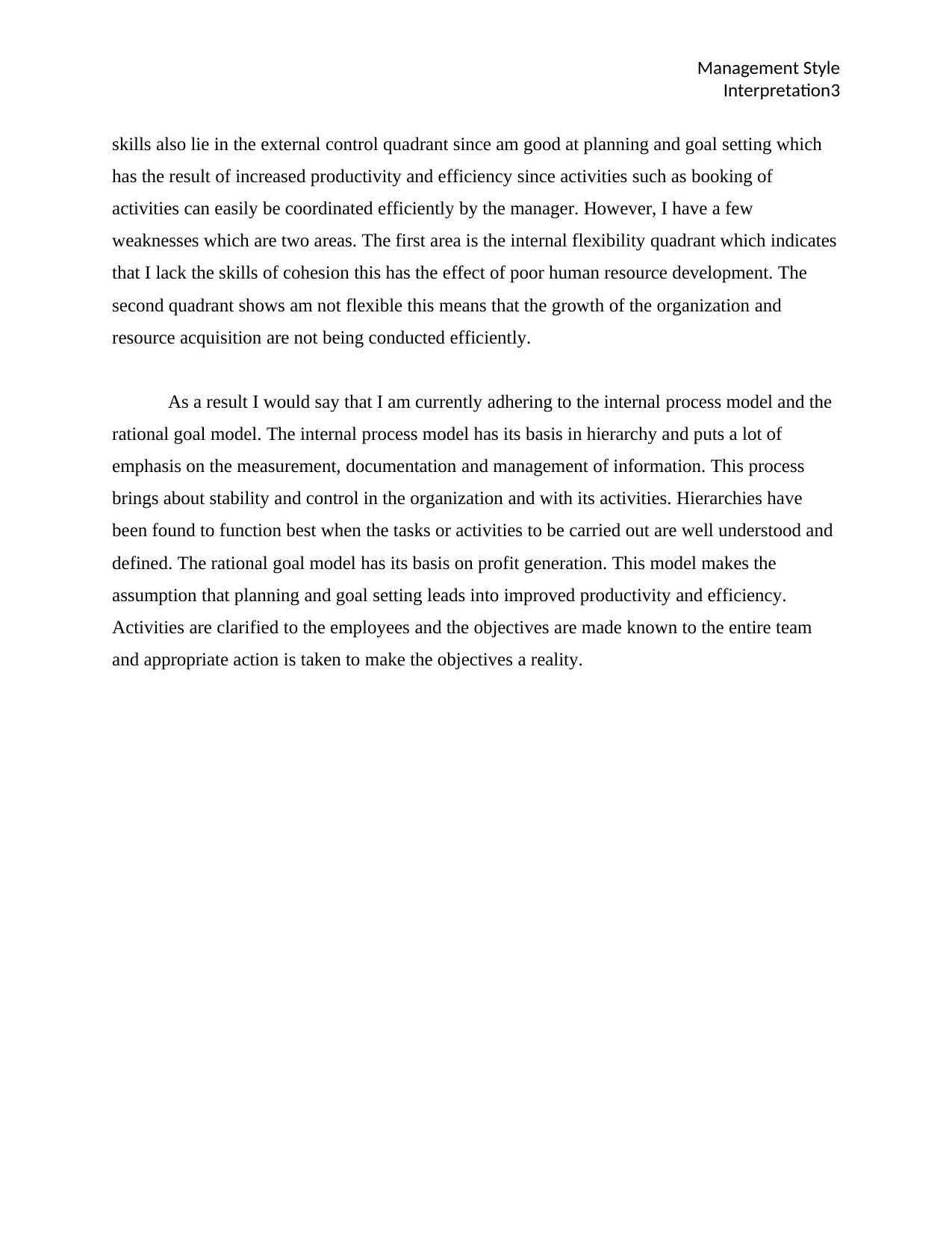
Management Style
Interpretation3
skills also lie in the external control quadrant since am good at planning and goal setting which
has the result of increased productivity and efficiency since activities such as booking of
activities can easily be coordinated efficiently by the manager. However, I have a few
weaknesses which are two areas. The first area is the internal flexibility quadrant which indicates
that I lack the skills of cohesion this has the effect of poor human resource development. The
second quadrant shows am not flexible this means that the growth of the organization and
resource acquisition are not being conducted efficiently.
As a result I would say that I am currently adhering to the internal process model and the
rational goal model. The internal process model has its basis in hierarchy and puts a lot of
emphasis on the measurement, documentation and management of information. This process
brings about stability and control in the organization and with its activities. Hierarchies have
been found to function best when the tasks or activities to be carried out are well understood and
defined. The rational goal model has its basis on profit generation. This model makes the
assumption that planning and goal setting leads into improved productivity and efficiency.
Activities are clarified to the employees and the objectives are made known to the entire team
and appropriate action is taken to make the objectives a reality.
Interpretation3
skills also lie in the external control quadrant since am good at planning and goal setting which
has the result of increased productivity and efficiency since activities such as booking of
activities can easily be coordinated efficiently by the manager. However, I have a few
weaknesses which are two areas. The first area is the internal flexibility quadrant which indicates
that I lack the skills of cohesion this has the effect of poor human resource development. The
second quadrant shows am not flexible this means that the growth of the organization and
resource acquisition are not being conducted efficiently.
As a result I would say that I am currently adhering to the internal process model and the
rational goal model. The internal process model has its basis in hierarchy and puts a lot of
emphasis on the measurement, documentation and management of information. This process
brings about stability and control in the organization and with its activities. Hierarchies have
been found to function best when the tasks or activities to be carried out are well understood and
defined. The rational goal model has its basis on profit generation. This model makes the
assumption that planning and goal setting leads into improved productivity and efficiency.
Activities are clarified to the employees and the objectives are made known to the entire team
and appropriate action is taken to make the objectives a reality.
⊘ This is a preview!⊘
Do you want full access?
Subscribe today to unlock all pages.

Trusted by 1+ million students worldwide
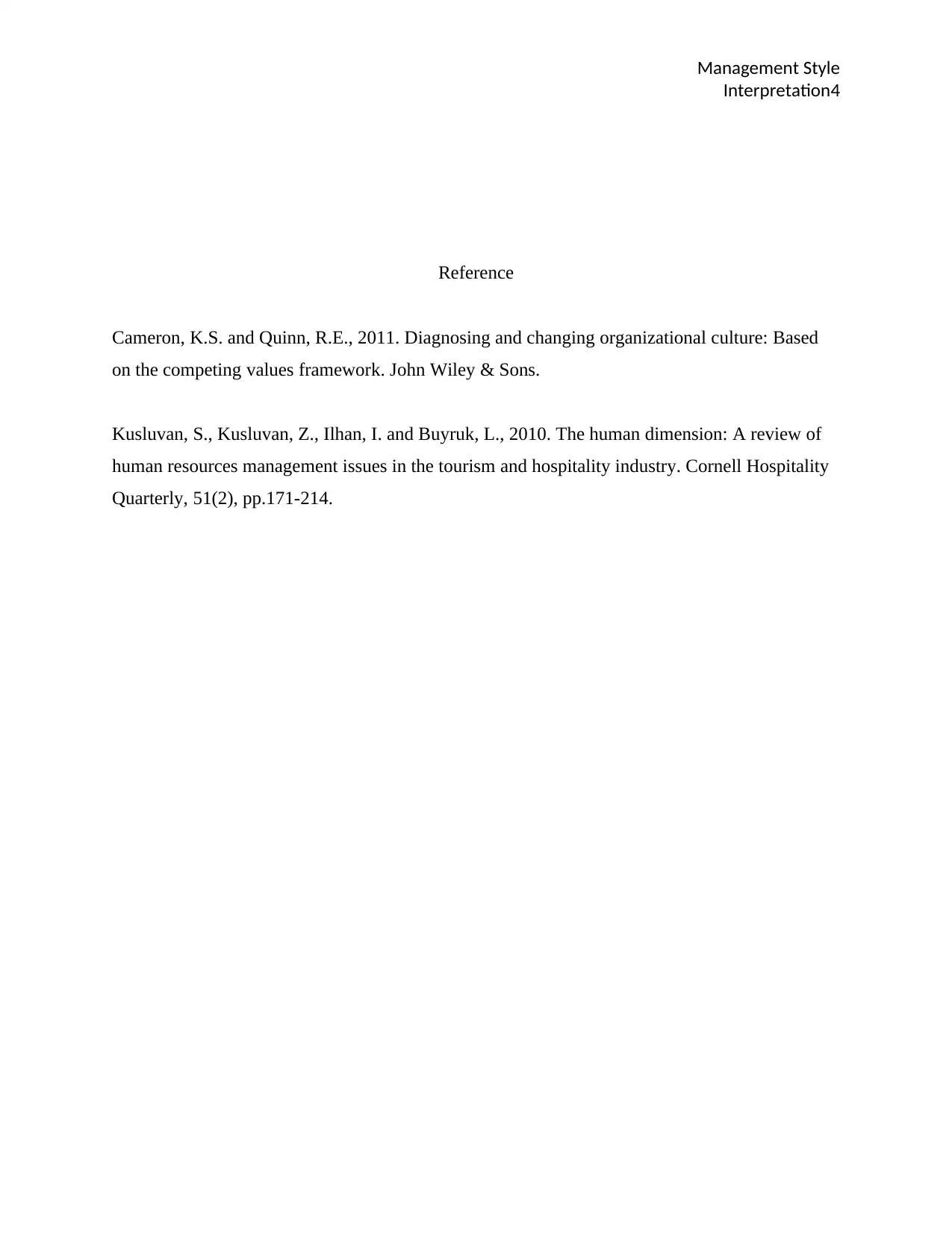
Management Style
Interpretation4
Reference
Cameron, K.S. and Quinn, R.E., 2011. Diagnosing and changing organizational culture: Based
on the competing values framework. John Wiley & Sons.
Kusluvan, S., Kusluvan, Z., Ilhan, I. and Buyruk, L., 2010. The human dimension: A review of
human resources management issues in the tourism and hospitality industry. Cornell Hospitality
Quarterly, 51(2), pp.171-214.
Interpretation4
Reference
Cameron, K.S. and Quinn, R.E., 2011. Diagnosing and changing organizational culture: Based
on the competing values framework. John Wiley & Sons.
Kusluvan, S., Kusluvan, Z., Ilhan, I. and Buyruk, L., 2010. The human dimension: A review of
human resources management issues in the tourism and hospitality industry. Cornell Hospitality
Quarterly, 51(2), pp.171-214.
Paraphrase This Document
Need a fresh take? Get an instant paraphrase of this document with our AI Paraphraser
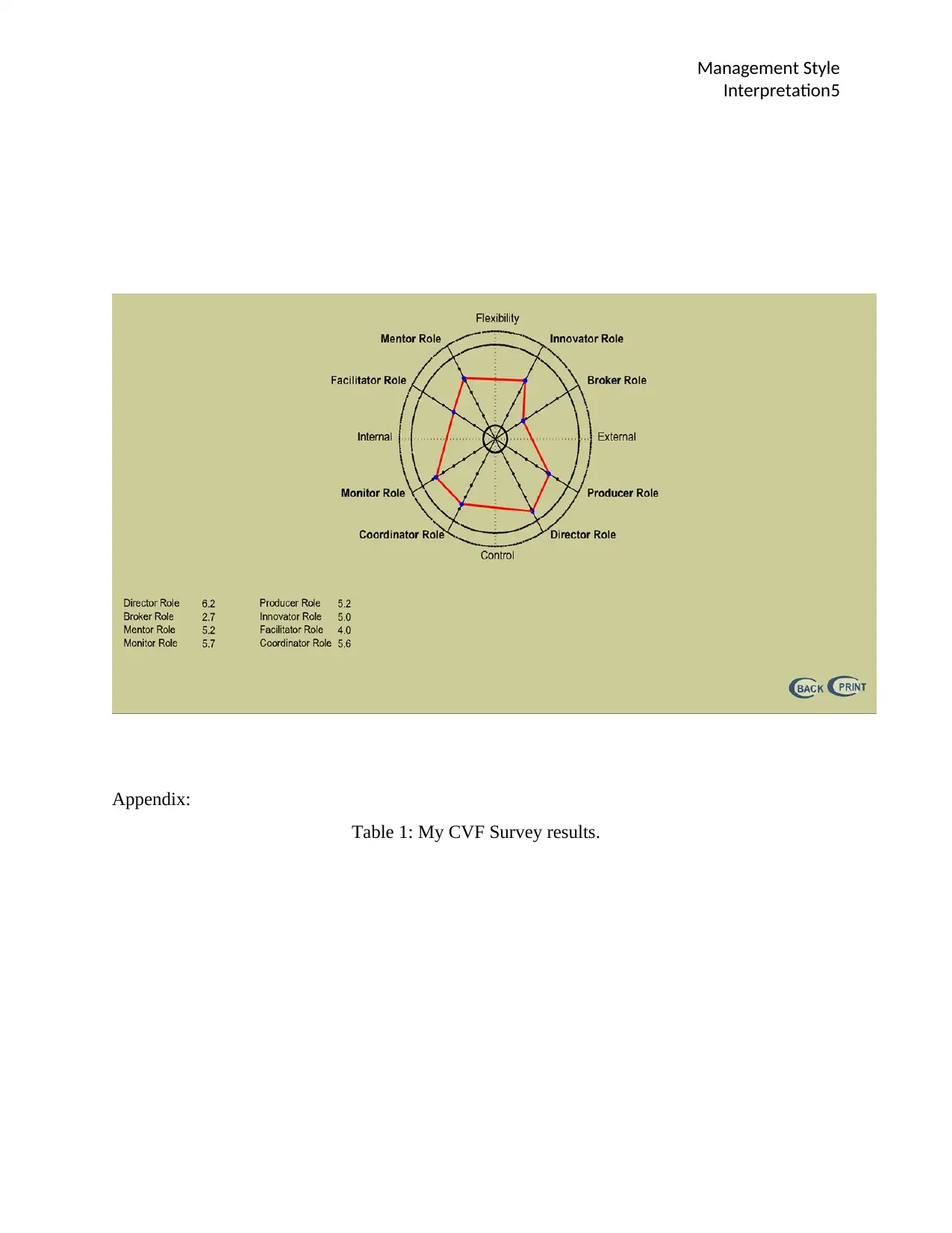
Management Style
Interpretation5
Appendix:
Table 1: My CVF Survey results.
Interpretation5
Appendix:
Table 1: My CVF Survey results.
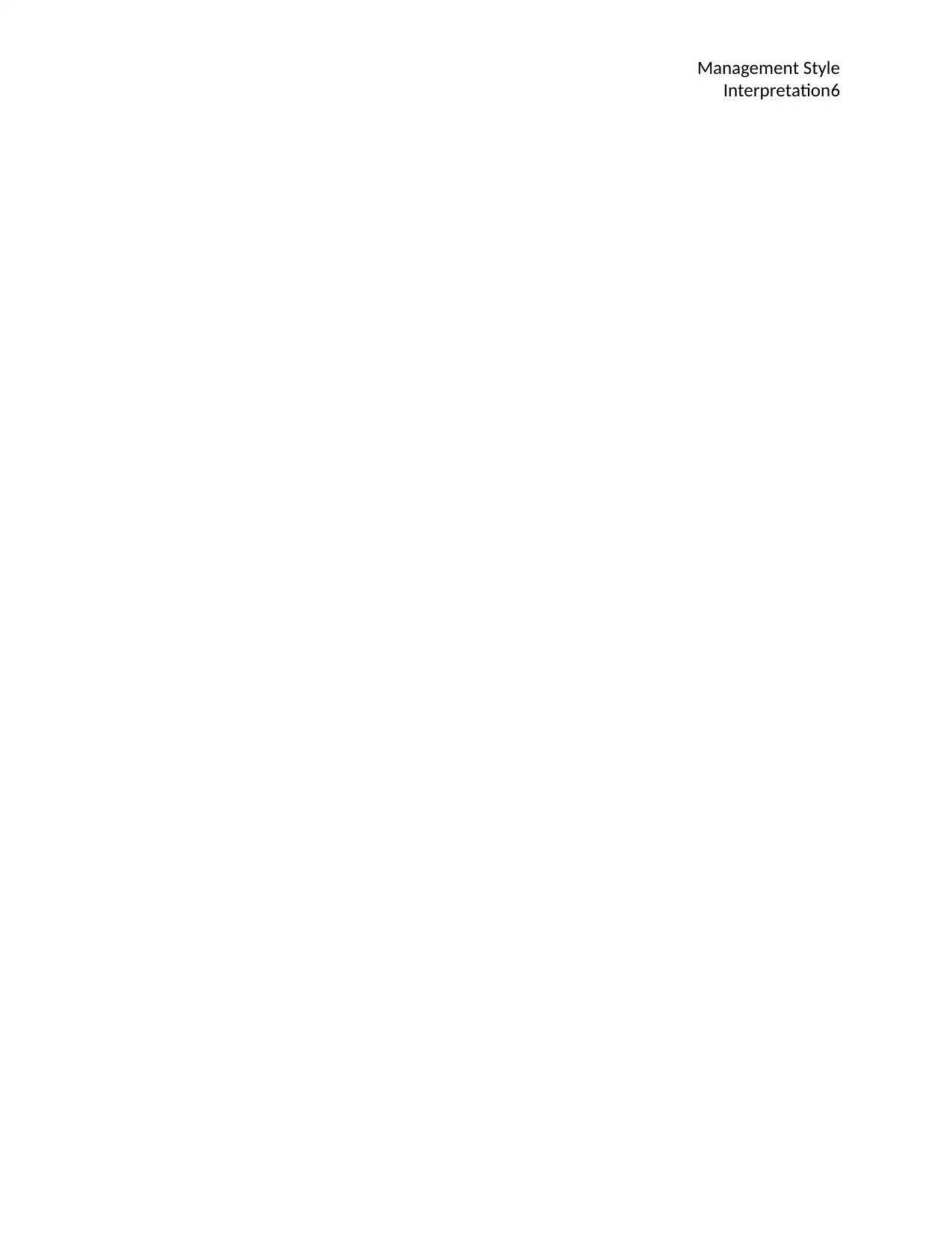
Management Style
Interpretation6
Interpretation6
⊘ This is a preview!⊘
Do you want full access?
Subscribe today to unlock all pages.

Trusted by 1+ million students worldwide
1 out of 6
Related Documents
Your All-in-One AI-Powered Toolkit for Academic Success.
+13062052269
info@desklib.com
Available 24*7 on WhatsApp / Email
![[object Object]](/_next/static/media/star-bottom.7253800d.svg)
Unlock your academic potential
Copyright © 2020–2025 A2Z Services. All Rights Reserved. Developed and managed by ZUCOL.





